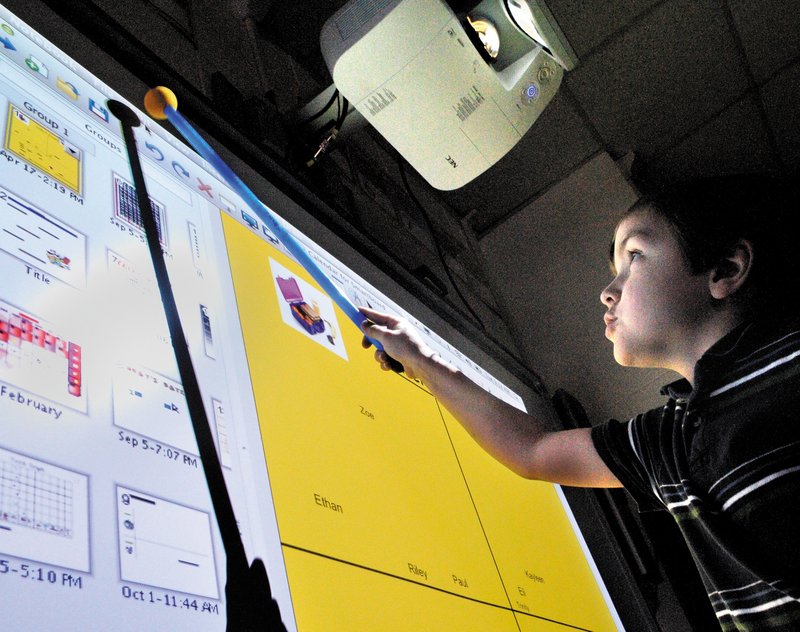AUGUSTA – In trying to bring technology into her classroom, Maureen Cooper started small.
The first-grade teacher at Gilbert Elementary School bought a few mp3 players so her students could listen to audio books and improve their listening and literacy skills.
Cooper’s personal budget could handle some small electronics, but not the next technology purchase she wanted to bring to her students: a SMART Board that cost about $4,500, with installation.
To find the funding, Cooper got creative. She wrote letters to local business owners to seek help, and three agreed to pitch in. The interactive whiteboard was installed in November.
“It’s amazing what I can do with it,” Cooper said. “I’m able to bring lessons right to the kids. We’re doing mapping right now. I’m able to go on Google Earth and actually show them streets and houses — the city, the state, the country, the world.”
Cooper’s fundraising shows how teachers are answering the question of how to supply and equip their classrooms when it’s not in their school district’s budget. As communities face the prospect of school cost-cutting or higher taxes, efforts such as Cooper’s are becoming more necessary for large supply purchases.
Cooper recently invited representatives from the three contributing companies — G&E Roofing Co., Gould Health Systems and On Target Utility Services — to her classroom to show them how her students are using the SmartBoard for interactive learning.
The companies were enthusiastic about helping, Cooper said.
“It’s amazing how people want to help if you just ask,” she said. “I was nervous sending out the letters, and that’s the kind of response I got.”
Many teachers simply dip into their own pockets to buy classroom supplies, especially less costly items such as crayons, paper and folders.
A survey by the National School Supply and Equipment Association showed that teachers spent $1.3 billion of their own money on supplies in 2009-10. On average, the teachers who took the survey said they spent $356 of their own money.
More than half of the teachers surveyed said classroom funding has decreased in recent years, prompting them to alter lesson plans, spend more of their own money or ask parents to buy more supplies.
Debbie Gagne, who teaches first grade at Lincoln Elementary School in Augusta, said she and her colleagues receive annual stipends for classroom expenses. “It’s gone down as the years have gone on,” she said. “Like everything.”
Gagne said she requests items in her newsletters but has tried not to add to her list of required supplies. This year, some parents bought her enough tissues and disinfectant wipes to last her to this point in the school calendar.
Gagne’s purchases last summer included large pillows to create a comfortable reading area in her classroom. At least some of her stipend went toward those.
“When it’s gone, it’s gone, and I just use my money after that,” she said. “It’s just part of teaching, I feel, like putting something back.”
Gagne also set up a list on teacherwishlist.com, a website that allows teachers to ask for gifts of items large or small. She said she didn’t publicize the list and promptly forgot about it.
Another website that teachers use is donorschoose.org. Teachers can request supplies or equipment for specific activities, such as vocabulary and phonics games for struggling readers.
Like Gagne, Monmouth Middle School social studies teacher Karenina Cooper set up an online wish list. But she hasn’t received anything from it. Teachers at her school no longer receive supplies stipends.
“Fortunately, by the time you get to the upper grades, we don’t do as many glitter-and-glue projects and stuff,” she said.
She does often buy supplies to do activities with her homeroom class — small things that add up.
“When the book fair comes, you buy a couple of books for the kids who you know don’t have money at home,” Karenina Cooper said. “A couple of bucks here, a couple of bucks there, but by the end of the school year, you’ve dropped a chunk of change.”
Parent-teacher organizations often are focused on elementary grades, but Monmouth’s sometimes helps the middle school, she said, including giving money to buy duct tape for building cardboard sleds during the school’s recent Winter Olympics.
There also are a few scattered grants, one of which Maureen Cooper received recently.
She said she hasn’t yet decided how to spend $1,000 from Walmart. She’s still focused on technology and is thinking about tablet computers to enable her students to do interactive work in math and reading.
Kennebec Journal Staff Writer Susan McMillan can be contacted at 621-5645 or at:
smcmillan@mainetoday.com
Send questions/comments to the editors.



Success. Please wait for the page to reload. If the page does not reload within 5 seconds, please refresh the page.
Enter your email and password to access comments.
Hi, to comment on stories you must . This profile is in addition to your subscription and website login.
Already have a commenting profile? .
Invalid username/password.
Please check your email to confirm and complete your registration.
Only subscribers are eligible to post comments. Please subscribe or login first for digital access. Here’s why.
Use the form below to reset your password. When you've submitted your account email, we will send an email with a reset code.